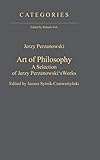Art of Philosophy : A Selection of Jerzy Perzanowski's Works / Jerzy Perzanowski; ed. by Janusz Sytnik-Czetwertynski.
Material type: TextSeries: Categories ; 3Publisher: Berlin ; Boston : De Gruyter, [2013]Copyright date: ©2012Description: 1 online resource (225 p.)Content type:
TextSeries: Categories ; 3Publisher: Berlin ; Boston : De Gruyter, [2013]Copyright date: ©2012Description: 1 online resource (225 p.)Content type: - 9783110321630
- 9783110321982
- 160 23
- BC108
- online - DeGruyter
- Issued also in print.
| Item type | Current library | Call number | URL | Status | Notes | Barcode | |
|---|---|---|---|---|---|---|---|
 eBook
eBook
|
Biblioteca "Angelicum" Pont. Univ. S.Tommaso d'Aquino Nuvola online | online - DeGruyter (Browse shelf(Opens below)) | Online access | Not for loan (Accesso limitato) | Accesso per gli utenti autorizzati / Access for authorized users | (dgr)9783110321982 |
Frontmatter -- SOURCES -- CONTENTS -- BIOGRAPHICAL NOTE -- Jerzy Perzanowski – Real Man and Real Philosopher -- Preface -- Jerzy Perzanowski’s Way to the Monadology -- Art of Philosophy -- In Praise of Philosophy -- Reasons for Monodeism -- Towards Combination Metaphysics -- Ontological Melioration -- Locative Ontology -- In Search of Ontological Conditions for Emergence -- Towards Psycho-ontology -- Modal Logics of Truth and Falsity -- Classical (Modal) Logics of the Square of Oppositions -- Combination Semantics for Intensional Logics, Makings and Their Use in Combination Semantics -- A Profile of Masonic Synthesis -- Bibliography
restricted access online access with authorization star
http://purl.org/coar/access_right/c_16ec
Jerzy Perzanowski’s ideas were based on an original blend of logic and ontology in what he called onto/logic, where the slash is meant to suggest a "ient of ontology by logic. Perzanowski began as a logician, his early works being on modal logic, then gradually shifted his interest to “logical philosophy”, meaning not so much philosophy of logic as philosophy informed by logic. Perzanowski was a rare breed of analytical philosopher who thought that a philosophical “theory of everything” was worthwhile. In this systematic spirit, he began with method. He presented his “method of total analysis and synthesis” quite simply: reduce the object of research to its simplest possible constituents, and then combine them in some way. Better still, combine them in every possible way, thereby producing a space of possibilities analogous to (and in certain cases identical with) the logical space. Thus, analysis and synthesis differ from a trivial disassembly and reassembly.
Issued also in print.
Mode of access: Internet via World Wide Web.
In English.
Description based on online resource; title from PDF title page (publisher's Web site, viewed 28. Feb 2023)


